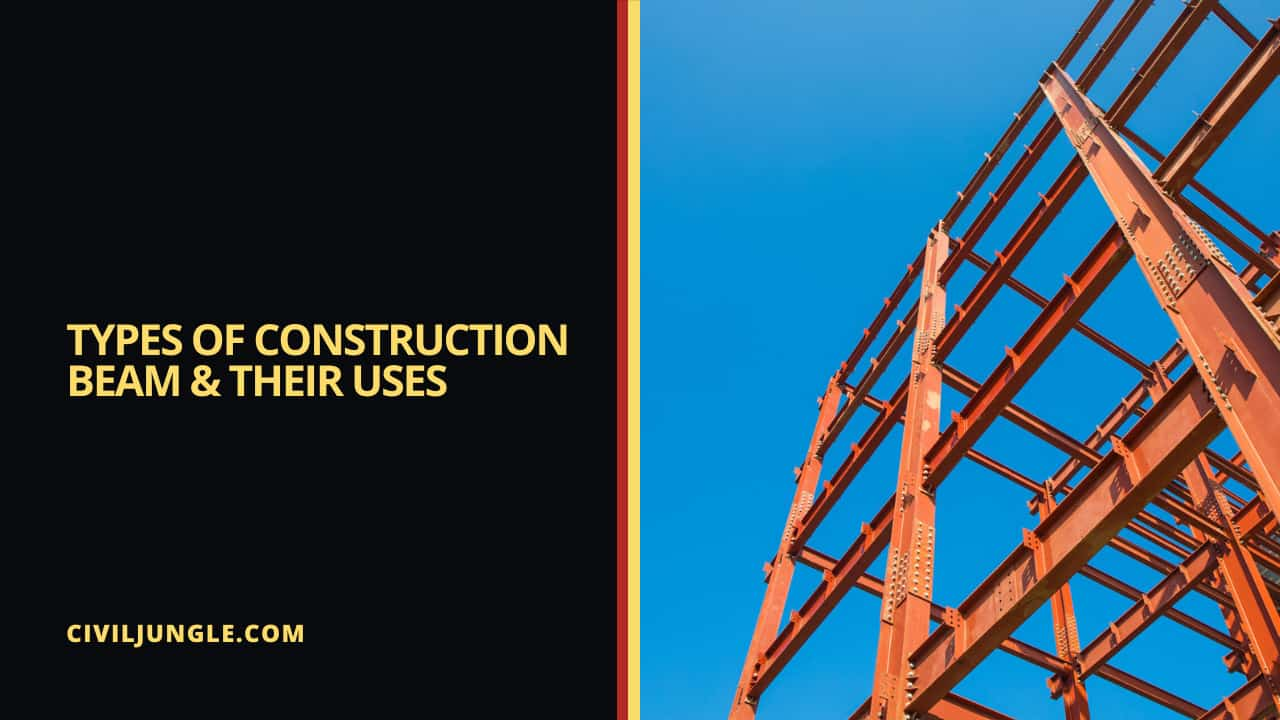
Introduction of Construction Beams
There are various types of construction beams are used in the buildings depending upon their function and the nature of work. Beams are generally constructed to support one or more points and the effective length of the beam between two and supports is known as the span of the Beam.
The Beam is basically a horizontal structural element that is constructed to support the slab and withstand the loads coming from the building. The Beam is connected to the columns to which it transmits the total load up to the foundation.
In this article, you will get to know about the Types of Construction Beams & their uses.
Types of Construction Beams
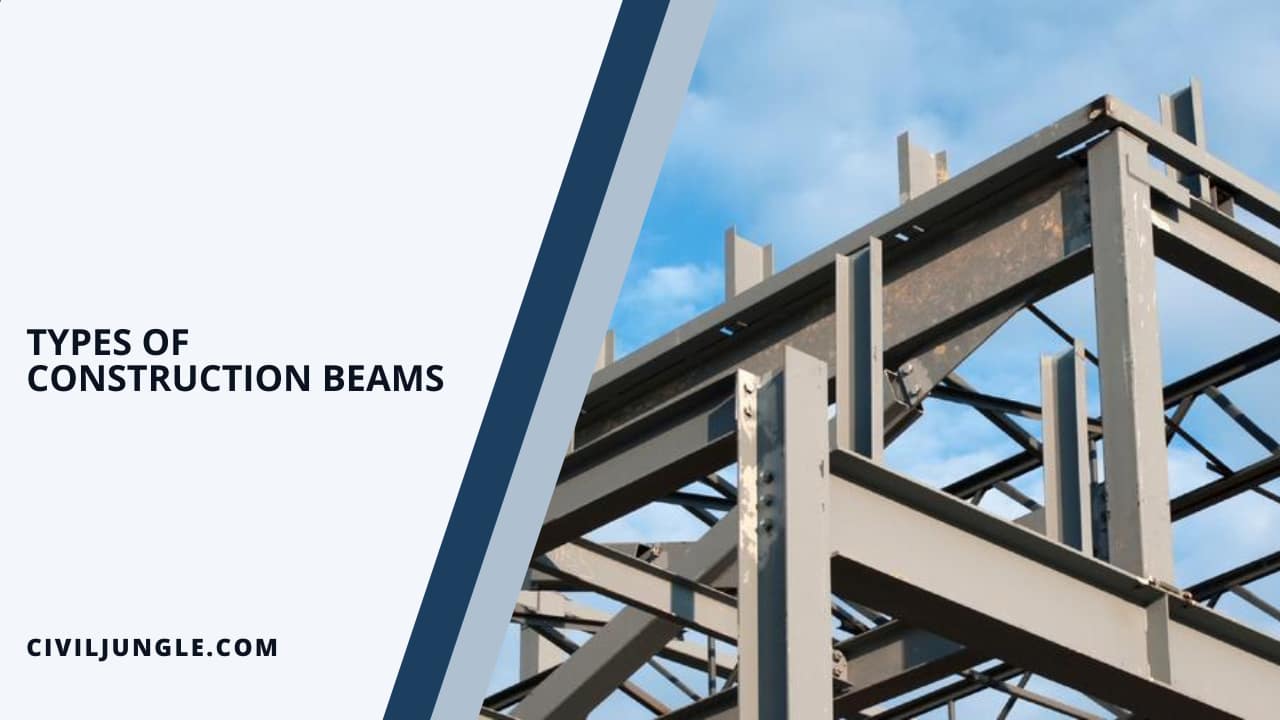
Beams are classified into various types according to their nature which are as follows.
Classification of the beam based on the construction material used
- Timber beam
- Concrete Beam
- Composite beam
- Steel beam
Classification of beams according to the support conditions
- Simply supported Beam
- Continuous beam
- Fixed beam
- Cantilever beam
- Overhanging beam
- Double overhanging beam
Classification of the beam according to Geometry
- Straight beam
- Curved beam
- Tapered beam
Classification according to the method of construction used
- Prestressed concrete beams
- Precast concrete beam
- In situ casted beams
Classification of beams according to the equilibrium condition
- Statically determinate beams
- Statically Indeterminate beams
Classification of beams according to its cross-examination
- I beam
- T beam
1. Timber Beam
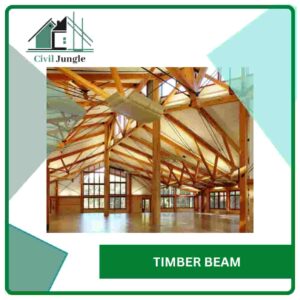
Timber beams are constructed from wood. A timber beam is a structural element that is used in the construction of both vertical columns as well as beams.
The timber beam consists of a single member or built-up member which is constructed from two or more members. The timber beam are designed to resist the bending moment and maximum horizontal shear stress.
Timber beam has very lightweight that’s why it is mostly used in the construction of structures where the dead load should be less. The timber beams are lightweight as compared to the concrete beam and steel beams.
Uses of Timber Beam
- Timber beams are generally used in the olden days for the construction of structures.
- Timber beams have widely used in the region where wooden available in large quantity.
2. Concrete Beam

Concrete beams are one of the most widely and commonly used beams in the construction of buildings. The concrete beam is constructed from the reinforced cement concrete which can take high compressive stresses.
Concrete beams are constructed to support the loads coming from the slabs and transmit through the column to the foundation.
We know that Concrete is good in compression and weak in tension. That’s why steel reinforcement has used the construction of concrete beam to increase its tensile strength.
Uses of Concrete Beam
- Concrete beams are used to carry the vertical as well as horizontal loads. Concrete beams have the ability to resist high compressive loads.
- Concrete beams used in the construction of bridges, foundations, and various structures.
3. Composite Beam
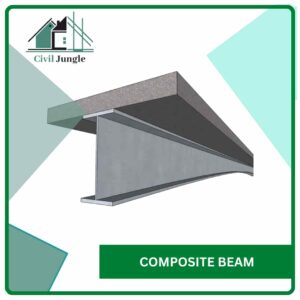
Composite beams at the type of beams that are constructed with the help of two or more materials. The two or more materials are used in the construction of the composite beams is to increase the strength and stiffness of the beam so that it can carry high loads.
Uses of Composite Beam
- Composite beams have used the construction of frame bridges.
- The composite steel and concrete beams are more widely used in which the Steel resist tensile stresses and the concrete resists compressive stresses.
4. Steel Beam
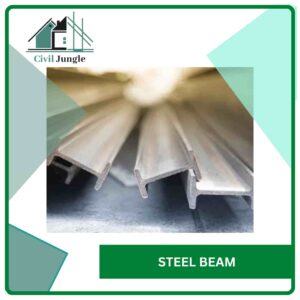
Steel beams are the structural beam which is constructed from steel to support the heavy loads. Steel beams have high strength and stiffness as compared to concrete beams. Steel beams are constructed in various shapes and sizes and it has different applications.
Uses of Steel Beam
The steel beams are generally used in the construction of steel structures, workshops, Steel roofs, trusses, and bridges, etc.
5. Simply Supported Beam

A simply supported beam is defined as the type of beam which is supported at both ends. The simply supported beam is freely supported on the walls are column at both ends.
This type of beam allows the horizontal movement of beam and generally undergoes both shear stresses as well as bending moment.
Uses of Simply Supported Beam
Simply supported beams are widely used in the construction of residential buildings.
6. Continuous Beam
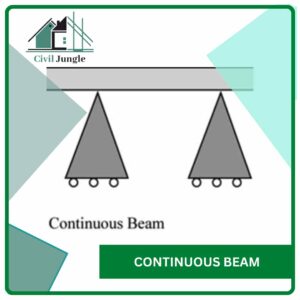
The continuous beam is a type of beam which is supported by more than two supports. In the case of the continuous beam, the end support of the continuous beam may be simply supported or fixed. Continuous beams have more stability as compared to other types of construction beam.
Uses of Continuous Beam
- The continuous beam is generally used in the construction of large span bridges whose length is too long.
- Continuous beams are also used while constructing long span slab and structures which has more than two supports in a continuous manner.
7. Fixed Beam
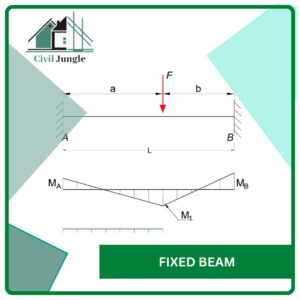
The Fixed-beam in defined as the type of construction beam whose both ends are fixed rigidly in the walls or any other structure. The Fixed beam cannot be able to rotate at its end.
The Fixed-beam does not allow movement in the vertical direction and the rotation of the beam. Fixed beam only undergoes shear stresses and there is no moment are produced at the end of the fixed beam.
Uses of Fixed Beam
The Fixed beams are used in the construction of trusses.
8. Cantilever Beam

A cantilever beam is a type of construction in which one end of the cantilever beam is fixed and the other end of the cantilever beam is free.
The cantilever beam is constrained at one end with the other end is extending freely outwards direction. When the cantilever beam is loaded the beam transfers load to its fixed end under the action of Bending.
Uses of Cantilever Beam
Cantilever beams are used in the construction of balconies and Cantilever slabs etc.
9. Overhanging Beam

Overhanging beam are defined as the types of construction beams whose end portion of the beam extends beyond the supports. The properties of the overhanging beams are same as the cantilever beam and simply supported Beams.
The overhanging beams are classified into two types such as overhanging beam on right side and overhanging beam on left side. The beam whose end portion extends beyond the supports on the right side is known as the overhanging beam on the right side.
The beam whose end portion extends beyond the supports in the left direction is known as the overhanging beam on left side.
Uses of Overhanging Beam
- An overhanging beam is used where it is not practical to provide a support to the beam at one end.
- You will frequently encounter overhanging beams in a floor beam which extends beyond the exterior wall of a building to support a balcony.
- It is also used to support roof extensions as in the picture below.
10. Double Overhanging Beam
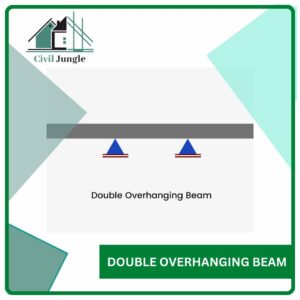
A double overhanging beam is a type of construction beam whose both ends extend beyond its supports.
11. Straight Beam
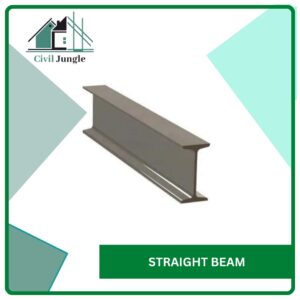
Straight beams are the type of construction beams which has a straight profile. The straight beam has an equal cross-section area throughout the length of the beam.
Uses of Straight Beam
- Beams are the horizontal members used to support vertically applied loads across an opening.
- In a more general sense, they are structural members that external loads tend to bend, or curve.
12. Curved Beam

The curved beam is a type of construction beam boots shape is curved and the centre of gravity of the curved beam always follows a curve.
Uses of Curved Beam
The curved beam is used for the construction of decorative structures or buildings.
13. Tapered Beam

The type or beam is a type of construction beam which is wider at the support and tapered at its end. Generally, cantilever beams are constructed in Tapered form because the moments are developed at end supports only.
Uses of Tapered Beam
- Tapered beam framing can be used to create offices, retail or other commercial space as well as warehouses up to 120 feet wide.
- Tapered rafter beams are paired with straight wall columns, simplifying the installation of straight interior walls.
14. Prestressed Concrete Beam
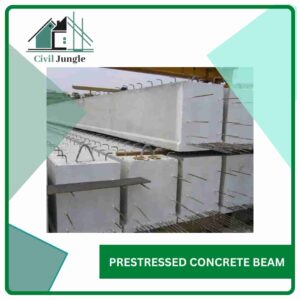
In the case of the prestressed concrete beams, the stresses are induced during its construction on site that’s why it is known as prestressed concrete beams. Prestressed concrete beams are more stable can carry higher stresses as compared to conventional concrete beams.
Uses of Prestressed Concrete Beam
- It is now commonly used for floor beams, piles and railways sleepers, as well as structures such as bridges, water tanks, roofs and runways.
- Generally, prestressed concrete is not necessary for columns and walls, however, it can be used economically for tall columns and high retaining walls with high bending stresses.
15. Precast Concrete Beam
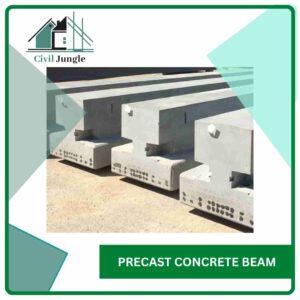
Precast concrete beams are also popularly known as cast-in-situ beams which are constructed at the factory as per the required size and specifications.
Precast concrete beams are constructed in the factory itself which is away from the construction site. The construction of the precast concrete beams is done under a controlled environment and supervision.
Uses of Precast Concrete Beam
Precast concrete beams are generally used where fast construction is required so that precast concrete beams are used.
16. In-Situ Cast Beam
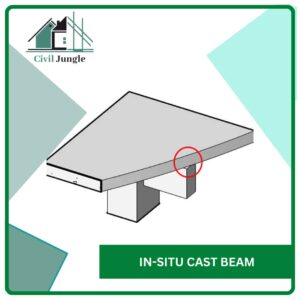
Cast-in-place concrete, also known as poured-in-place, is a concreting technique which is undertaken in situ or in the concrete component’s finished position.
Cast-in-place concrete is the preferred choice for concrete slabs and foundations, as well as components such as beams, columns, walls, roofs, and so on.
Uses of In-Situ Cast Beams
Cast in situ concrete is appropriate for all types of basement construction. It is a common form of basement construction for residential use, due to its relatively simple application, adaptability, and cost.
17. Statically Determinate Beam
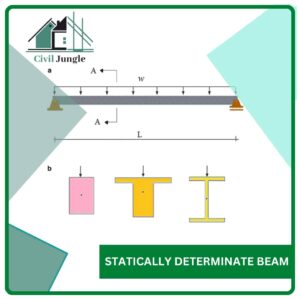
Statically determinate beams are defined as the beams which can be analyzed by using basic equilibrium conditions. The support reactions which are developed in these beams can be calculated with the help of basic equilibrium conditions.
The condition which is used to analyze the statically determinate beam is the summation of all the horizontal forces is equal to zero. The summation of all vertical forces and all moments is zero. The simply supported beam and cantilever beams are one of examples of statically determinate beams.
Uses of Statically Determinate Beam
Simply supported beams, cantilever beams, single and double overhanging beams, three-hinged arches, etc.
18. Statically Indeterminate Beam
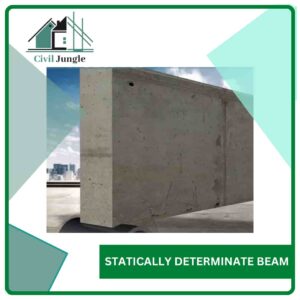
Statically indeterminate beams are defined as the beams which cannot be analyzed with the help of basic equilibrium conditions.
The end reactions which develop in the case of statically determinate beams are calculated by using the Strain energy method. The stresses in the statically indeterminate beams are less as compared to the statically determinate beams.
Uses of Statically Indeterminate Beams
Statically indeterminate structures are fixed beams, continuous beams, fixed arches, two hinged arches, portals, multistoried frames, etc.
19. I Section Beam
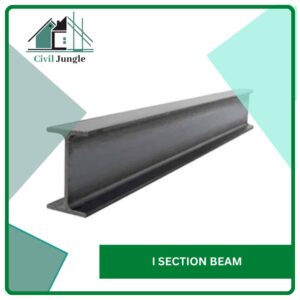
I beams are one of the commonly used beams in the construction of steel structures. I beam has a greater moment of inertia due to which it has high resistance to the deflection and the bending moment.
I section beams are manufactured in the factory with the help of steel. I section consists of the top flange, web, and bottom flange.
Uses of I Section Beam
They are often used as critical support trusses, or the main framework, in buildings. Steel I beams ensure a structure’s integrity with relentless strength and support.
20. T Section Beam
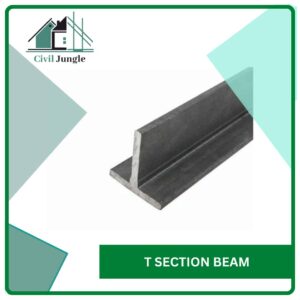
A T–beam (or tee beam), used in construction, is a load-bearing structure of reinforced concrete, wood, or metal, with a T-shaped cross-section.
The top of the T-shaped cross-section serves as a flange or compression member in resisting compressive stresses. Done properly, the slab acts as the compression flange.
Uses of T Section Beam
This types of beams are widely used in the construction of steel structures.
FAQ: Types of Construction Beams
What is a construction beam?
A construction beam is a horizontal structural element designed to support loads from the building, transferring these loads to columns and ultimately to the foundation. Beams can be constructed from various materials and come in different types based on their support conditions, geometry, construction method, equilibrium condition, and cross-sectional shape.
What are the primary materials used for constructing beams?
The primary materials used for constructing beams include timber, concrete, composite materials, and steel. Each material has specific properties that make it suitable for different types of construction.
What are timber beams, and where are they used?
Timber beams are constructed from wood and are lightweight. They are often used in structures where a low dead load is necessary. Timber beams were widely used in older structures and in regions with abundant wood resources.
Why are concrete beams widely used in construction?
Concrete beams, made from reinforced cement concrete, can withstand high compressive stresses and are reinforced with steel to increase tensile strength. They are used to support vertical and horizontal loads and are commonly found in bridges, foundations, and various other structures.
What are composite beams?
Composite beams are constructed using two or more materials to enhance their strength and stiffness. These beams are often used in frame bridges, where steel resists tensile stresses and concrete resists compressive stresses.
What are the advantages of steel beams?
Steel beams have high strength and stiffness, making them ideal for supporting heavy loads. They are used in constructing steel structures, workshops, steel roofs, trusses, and bridges. Steel beams come in various shapes and sizes to suit different applications.
How are beams classified based on support conditions?
Beams are classified into several types based on support conditions:
- Simply Supported Beam
- Continuous Beam
- Fixed Beam
- Cantilever Beam
- Overhanging Beam
- Double Overhanging Beam
What is a simply supported beam?
A simply supported beam is supported at both ends, allowing horizontal movement and undergoing both shear stresses and bending moments. It is widely used in residential buildings.
What are the characteristics of a continuous beam?
A continuous beam is supported by more than two supports, providing more stability. It is often used in constructing large-span bridges and long-span slabs.
What defines a fixed beam?
A fixed beam has both ends rigidly fixed, preventing vertical movement and rotation at its ends. It primarily undergoes shear stresses and is used in constructing trusses.
What is a cantilever beam, and where is it used?
A cantilever beam has one fixed end and one free end, extending outwards. When loaded, it transfers the load to the fixed end. Cantilever beams are commonly used in balconies and cantilever slabs.
What are overhanging beams?
Overhanging beams extend beyond their supports on one or both ends, similar to cantilever and simply supported beams. They are used where providing support at one end is impractical, such as in floor beams supporting balconies and roof extensions.
What is a double overhanging beam?
A double overhanging beam extends beyond its supports on both ends, providing additional support and stability.
How are beams classified according to geometry?
Beams are classified into:
- Straight Beam
- Curved Beam
- Tapered Beam
What are straight beams used for?
Straight beams have a uniform cross-section and are used to support vertically applied loads across openings. They are structural members that bend or curve under external loads.
What are curved beams?
Curved beams have a curved shape, with their center of gravity following a curve. They are used for constructing decorative structures and buildings.
What are tapered beams?
Tapered beams are wider at the support and tapered at the ends, often used in cantilever form to handle moments at end supports. They are used in constructing offices, retail spaces, warehouses, and roofs.
What are prestressed concrete beams?
Prestressed concrete beams have induced stresses during construction, providing more stability and the ability to carry higher loads compared to conventional concrete beams. They are used in floors, piles, railway sleepers, bridges, water tanks, roofs, and runways.
What are precast concrete beams?
Precast concrete beams are constructed off-site in a factory under controlled conditions. They are used where fast construction is needed, such as in precast buildings and structures.
What is an in-situ cast beam?
In-situ cast beams, also known as cast-in-place beams, are constructed on-site in their final position. They are used for concrete slabs, foundations, beams, columns, walls, and roofs.
What are statically determinate beams?
Statically determinate beams can be analyzed using basic equilibrium conditions, with support reactions calculated through the summation of horizontal forces, vertical forces, and moments. Examples include simply supported and cantilever beams.
What are statically indeterminate beams?
Statically indeterminate beams cannot be analyzed with basic equilibrium conditions alone. They require methods like the Strain energy method for calculating end reactions. Examples include fixed beams, continuous beams, and multi-storied frames.
What is an I section beam?
I section beams, also known as I beams, have a high moment of inertia, providing resistance to deflection and bending moments. They consist of a top flange, web, and bottom flange and are used in critical support structures in buildings.
What is a T section beam?
A T section beam, or T-beam, has a T-shaped cross-section, with the top part serving as a flange to resist compressive stresses. They are used in constructing steel structures.

